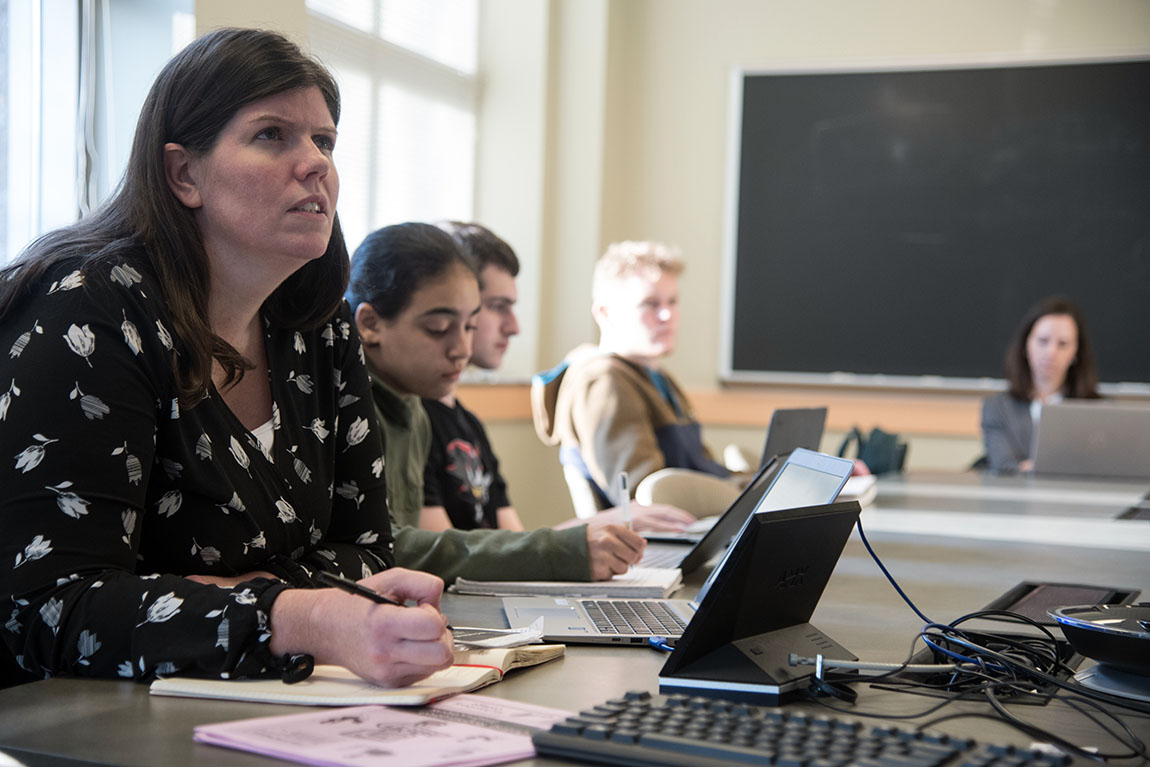How Knowledge (or Misinformation) Spreads
One integrative learning course examines how scientific information travels from scientists to other scientists, to the media and to the rest of the world.By: Meghan Kita Wednesday, November 20, 2019 10:05 AM
 Teaching and Learning Librarian Rachel Hamelers (left) leads a discussion in her Scientific Communication integrative learning course. Photo by Tom Amico
Teaching and Learning Librarian Rachel Hamelers (left) leads a discussion in her Scientific Communication integrative learning course. Photo by Tom AmicoBefore this semester, Maddie Taradash ’21, a business administration and media & communication double major, had a clear sense of what professors thought of one popular website: “I was always told that Wikipedia was the anti-source,” she says. It’s easy to see why—anyone can update Wikipedia, and it’s vetted by a team of volunteer editors who may or may not catch mistakes or lies introduced into one of the site’s millions of articles.
However, Teaching and Learning Librarian Rachel Hamelers understands that, for better or for worse, when a person is searching for information online, Wikipedia is often one of the first resources they’ll find. So, students in her integrative learning course Scientific Communication learn to update Wikipedia with information from quality sources.
The final project involves either creating an article or adding a section to an existing article about something in the scientific sphere. Early in the semester, students practice by adding information and citations to an entry about a cancer researcher of their choosing from an under-represented group. All first-timers trying to update Wikipedia are scrutinized by its volunteer editors, and students learn how that group’s worldview might shape which edits are accepted.
“You hear about how similar Wikipedia editors are,” Hamelers says, “and if you put something out there by people who are not white, Western males, you can—and we have—gotten a lot of pushback from certain editors.” Some of her students’ edits have been rejected, she says, because the editors said they needed to provide “better secondary sources.” The secondary sources in question were articles in The New York Times and The Washington Post about the subjects and their research. “What better secondary sources are there?” Hamelers says.
Throughout the semester, the class examines the science behind things like climate change, the opioid crisis and vaccines and how that science has been communicated to other scientists, to the public and to policymakers. The HIV/AIDS epidemic in the United States serves as the largest case study, with David France’s How to Survive a Plague: The Inside Story of How Citizens and Science Tamed AIDS as required reading. Students are often surprised to learn how poorly the disease was understood by those outside the scientific community in the 1980s.
To complete the integrative learning requirement, students must take Biology Lecturer Debra Walther’s course From DNA to Cancer in the spring. In that course, students examine the science behind this particular class of diseases—and, thanks to their experience in Hamelers’s course, they should be able to imagine how that science might best be shared.
“The idea of the linked courses is to look at an issue from different lenses,” Hamlers says. “The idea of mine is: It doesn't matter if you have really good science. If it doesn’t get to anyone, it’s not helping anyone.”
